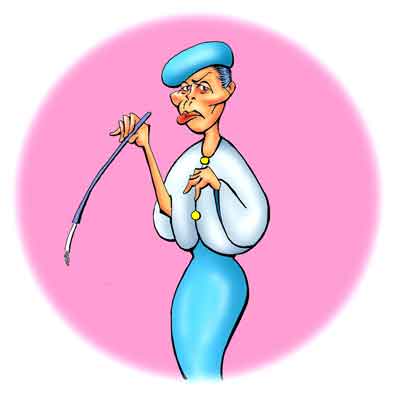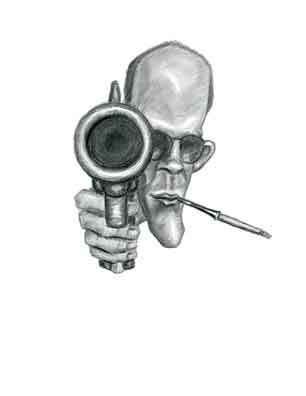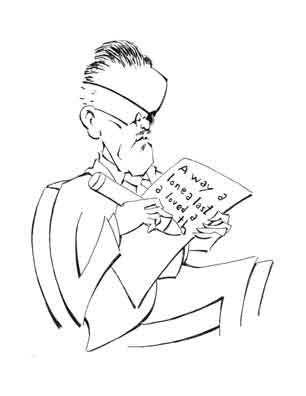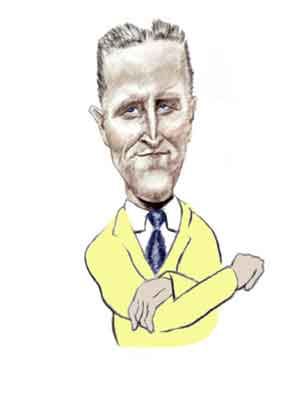Djuna Barnes
Famously Unknown

Djuna Barnes
La Journaliste Gonzienne
(Click image to zoom in and out.)
On September 6, 1914, an article appeared in the Brooklyn Daily Eagle titled "How It Feels to Be Forcibly Fed". The writer had voluntarily submitted to being wrapped in sheets and having a tube inserted through her nostrils down to her throat and having milk poured through the tube. Obviously - from the title of this essay - the writer was Djuna Barnes.
Djuna had a purpose for this early example of what some now call gonzo journalism (yes, Djuna was there before Hunter S. Thompson). At the time the article appeared there were many women who were pushing for women's rights, particularly the right to vote. Because these ladies took an activistic and even confrontational approach to achieving their goals, they sometimes ended up getting thrown in the slammer for various charges.

Hunter S. Thompson
Djuna was there first.
And once incarcerated the girls wouldn't behave even then! They sometimes trashed their prison cells, were disrespectful to the guards, and would even go on hunger strikes. Although there wasn't much the prison authorities could do about the trashed cells or disrespect, to deal with the hunger strikes, the women would be force fed - and pretty much as Djuna described.
So Djuna wanted to find out - and report - what the suffragettes (as they were called) - went through for doing nothing more than working for equal rights. As you may guess, the experience was not pleasant.
With such a participatory approach - some say sensationalist - to journalism, it's not really a surprise that although Djuna had only been working for a year as a reporter, she had already become a celebrity.
The first decades of the 20th century were a time when reading newspapers and magazines was popular entertainment, and Djuna found she could get paid about $15 for a story or illustration. Unlike today where it is considered the height of chic to spend your time watching 24/7 sports programs, swilling cheap beer, and wolfing down mega-bags of chips and pretzels, in Djuna's time it was cool to be literary. Authors and reporters might be as famous as the stars of the stage or the newly emerging entertainments radio and cinema. Fiction was popular and was even printed in newspapers.
So many journalists would also turn to writing short stories, novels, and even poetry. They didn't need to waste time with the big publishers who wanted to make money. Instead there were small avant-garde presses that would crank out a couple of hundred copies at minimal costs.
In 1915 Djuna published The Book of Repulsive Women. This was a collection of eight poems and illustrated with five drawings. Published by Bruno Chap Books, it sold for fifteen cents1.
Footnote
Bruno Chap Books was a courteously named publishing house run by Guido Bruno whose real name was Curt Josef Kisch. An immigrant from Prague, he settled around Greenwich Village's Washington Square. He published a number of counterculture magazines featuring new authors and helped organize exhibits of artists he thought of merit.
But before we go further, a bit about Djuna's background.
Djuna Barnes was born in a log cabin ...
Yes. This is correct. In 1892 Djuna was born in a log cabin that had been the family home for some time. The cabin was in the town of Cornwall-on-Hudson about 50 miles north of New York City. Despite the humble origins, the family was well-to-do but quite strange. Her dad, Henry Budington, was an artist and writer who lived largely on his inherited wealth. Why we read about Djuna Barnes and not Djuna Dubington is because Henry and his wife, Elizabeth, split when Djuna was still young. Her mom returned to using her own surname which was Barnes. They moved in with Elizabeth's mom who held the radical view that women should be allowed to vote.
Djuna never formally attended school except for a brief time at the Pratt Art Institute in Brooklyn. But she was educated at home which was not unusual for uppercrust kids whose parents didn't want them to associate with riff-raff, ruffians, and yahoos.
Details of Djuna's early years are a bit shadowy. Sources state she was married to a man named Courtenay Lemon, although some writers don't seem sure if it was a formal legal marriage, a common law union, from her own choice, or was a "forced" marriage. In any case the marriage - whatever kind it was - didn't last long.
By 1920 and in her late twenties, Djuna had become well-enough known as a journalist that she went to Paris for McCall's magazine. Although some write of Djuna's lucrative deal with McCall's as being "on assignment", apparently she was paid on a per-story basis. So she was free to write articles for other papers and magazines which she did.
In her first years in Paris Djuna lived at the Hotel Jacob2, a hangout for the artsy people. There she began an intimate relationship with a young sculptor and silverpoint artist, Thelma Wood. The relationship was not tranquil although it lasted until Thelma returned to New York in the late 1920's. Also lifestyles of those along the Left Bank were not always the healthiest as it involved staying out late at bistros, restaurants, and dance halls with considerable smoking and drinking. Djuna was already smoking and now she began to drink to excess.
Footnote
Students of early 20th century literature have noted the connection of the name Jacob Barnes, the protagonist of Ernest Hemingway's The Sun Also Rise with Djuna Barnes who lived at Hotel Jacob. Whether this was intentional or not, such apparent associations can arise by coincidence. After all, Natalie Barney's "salon" was at 20 rue Jacob.
Like most labeled generations, the Lost Generation has been variously defined. The narrow definition is limited to the international community who lived in Paris as young men and women after World War I, particularly those who became artists and writers. Others speak more broadly and say it's the generation born roughly between 1880 and 19003. So you can include the grand old men like James Joyce and the kids and young whippersnappers like Ernest Miller Hemingway.
Footnote
The best definition seems to be the narrow one. For instance although both J. R. R. Tolkien and C. S. "Jack" Lewis were born in the proper time frame and both served in World War I and both men became authors, neither is considered a Lost Generation writer.

James Joyce
The Grand Old Man

Ernest Hemingway
The Whippersnapper.
It's well to remember that there was no conscious movement called a Lost Generation. Most of the Lost Generation had never heard the term until Ernest's book The Sun Also Rises was published. Ernest himself said he disagreed with the label and was simply repeating what Gertrude Stein had once said when talking about a young American garage mechanic.
So whether there was really a Lost Generation or not, Djuna soon became well known to the Paris crowd. As an established journalist, she took to writing literature. But she did not just "crank" them out, and her first novel, Ryder, was not printed until 1928, eight years after she settled in Paris. The novel is what are now called "modernist" and was printed by Boni and Liveright, a publishing firm known for taking chances but nevertheless was respectable enough.
The Lost Generation was in many ways a subset of the bohemians. The bohemians formed the counterculture of the time and eventually morphed into the beatniks and then the hippies. There are differences, though, between the groups. The bohemians like the beatniks were largely apolitical, but the hippies flouted their politics with a vengeance.
But bohemians were unconventional, and one of their characteristics was that they really didn't care what your personal proclivities or preferences were. And soon Djuna became known as preferring same gender relationships, much as did Sylvia Beach who was the first publisher of James Joyce's Ulysses.

Sylvia Beach
Of the same preferences.
The same year as Ryder appeared, Djuna published the Ladies Almanack or Ladies Almanack: Showing Their Signs and Their Tides; Their Moons and Their Changes; the Seasons as It Is With Them; Their Eclipses and Equinoxes; As Well as a Full Record of Diurnal and Nocturnal Distempers, Written & Illustrated by a Lady of Fashion. The book, if not he long-winded title, raised the eyebrows. Written as a pastiche in the old roguish style of ribaldry and describable as a Sapphic Tom Jones, the book is a satiric fictionalization based on people in the circle of Natalie Barney, a well-to-do American expatriate, who made no bones that she preferred ladies to gentlemen.
The Lost Generation in Paris only lasted a couple of years longer. By 1930 most of the expatriates had repatriated themselves back to their home countries. For most of them was the United States. Although various reasons have been offered for the collapse of what was really a pretty nice way of living, mostly it was because of the Great Depression of 1929. Whether you were a writer living off the family's wealth (like Scott Fitzgerald), managing off their wife's trust funds (like Ernest Hemingway), or getting their rich friends to pay their bills (like James Joyce), the money began to dry up. Djuna, though, remained in Paris.

F. Scott Fitzgerald
Living Off the Wealth
Djuna's drinking got steadily worse and even her bohemian friends began to worry about her. But by now Djuna was a good friend of Peggy Guggenheim, the wealthy heiress who was not only an avid art collector but also acted as a "patron" to a number of artists and writers. So Peggy began to help cover Djuna's expenses.
It wasn't until 1936 that Djuna published her next book, Nightwood. Like Ladies Almanack this dealt with same gender relationships mostly regarding women although one of the male characters is a cross-dresser. But Nightwood was a more serious novel than Ryder and more explicit. There were also religious allusions that were troublesome to those who saw religion in traditional terms. The nature of the book made it inevitable that publishers would be leery of committing themselves to the book. But finally the famous poet (and editor) Thomas Stearns Eliot - yes, the same T. S. Eliot who wrote Cats4 - thought it was a great book and recommended its acceptance by Faber and Faber.
Footnote
And T. S. also wrote the long, serious, important, and so far less entertaining poem The Wasteland. But if people know of T. S., they know Cats or at least its Broadway incarnation.
Nightwood was one of those books that is praised by the critics and praised by the public - at least those who read it. But that wasn't very many, and Djuna made virtually no money from it.
What made matters worse is that by the time Nightwood was published, scary times were coming. Maria Schicklgruber's grandson had been Chancellor of Germany for three years, and the jutted-jawed father of jazz pianist Romano Full had invaded Ethiopia. In two more years came Kristallnacht and the Anschluß, and the next year, 1939, Djuna returned to New York.
Back in New York, Djuna found a small apartment in Greenwich Village. She kept writing but published virtually nothing and her living expenses were picked up by Peggy. Djuna eventually gave up smoking and drinking but faded from the literary scene. Older people wondered what had become of her and the younger ones never knew she existed.
In recent years, though, interest in Djuna, her life, work, and art has undergone a revival. Much of her writings have been republished and has found a new audience. She is, though, still relatively unknown to the general public and remains as she herself once said, the most famous unknown author in the world.
Djuna continued to live in her small apartment for the rest of her life. That was until June 18, 1982.
References
Djuna: The Life and Work of Djuna Barnes, Phillip Herring, Viking, 1995.
"Daily Rituals: Women at Work", Mason Currey, Knopf, 2019.
"How It Feels to Be Forcibly Fed", Djuna Barnes, Brooklyn Daily Eagle, September 6, 1914.
"How Every Generation of the Last Century Got Its Nickname", Josh Sanburn, Time, December 2, 2015.
"Djuna Barnes", It Happened in History!, American Society of Authors and Writers.
"The Life of Djuna Barnes, Stunt Reporter and Shocking Modernist", Laura June, Jezebel, June 3, 2015.
"Newspaper Fiction: The New York Journalism of Djuna Barnes, 1913-1919", Elizabeth A Sackler Center for Feminist Art, January 20-August 19, 2012.
"Djuna Barnes's Writing Is Exhilarating - But Steeped in the Worst of Its Era", Sam Jordison, The Guardian, May 22, 2018.
"The Stature of an Eccentric", Phyllis Rose, The New York Times, June 26, 1983.
The Book of Repulsive Women: 8 Rhythms and 5 Drawings, Djuna Barnes, Edited by Guido Bruni in His Garret on Washington Square, New York, November, 1915.
New York City: A Cultural and Literary Companion, Eric Homberger, Signal Books, 2002.
"Guido Bruno: A Literary Vagabond", Tuesday, Rose Durand, Museum of the City of New York. February 27, 2018.
"The most famous unknown author", Ellen Battersby, The Irish Times, April 13, 1996.